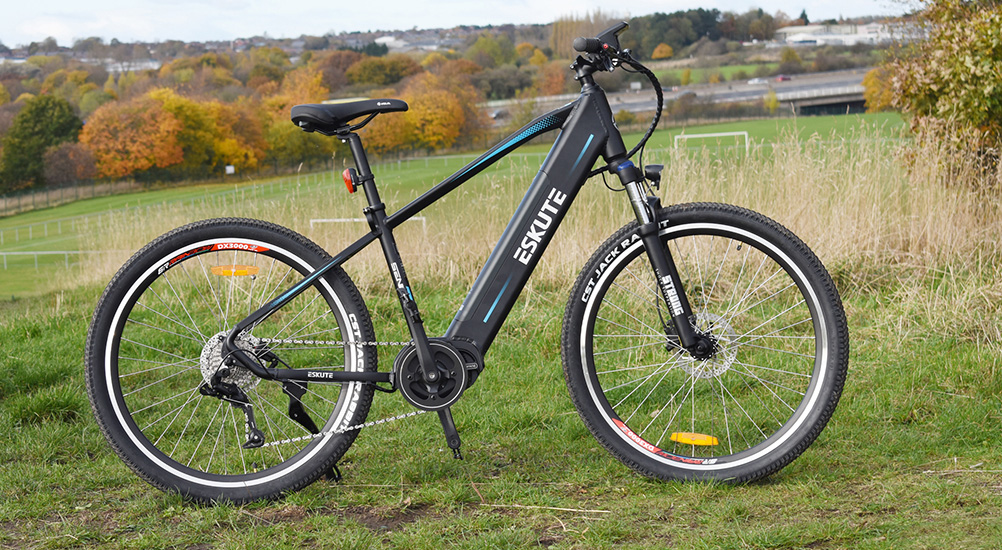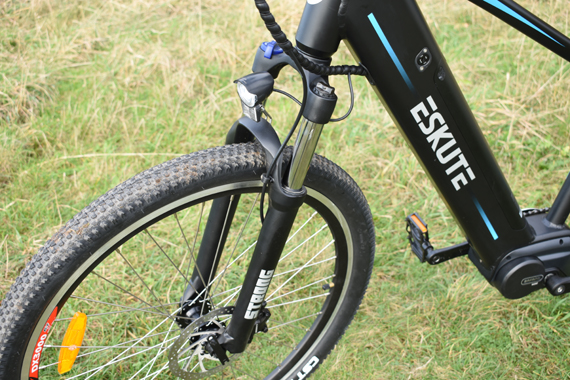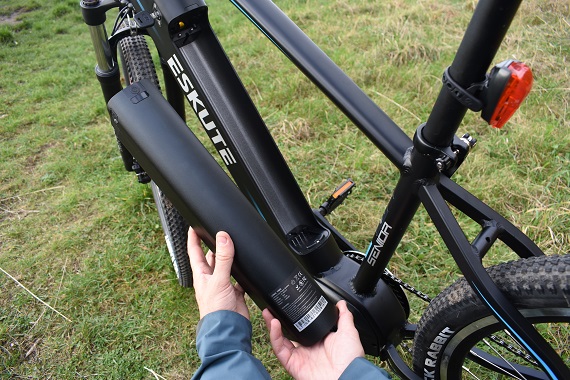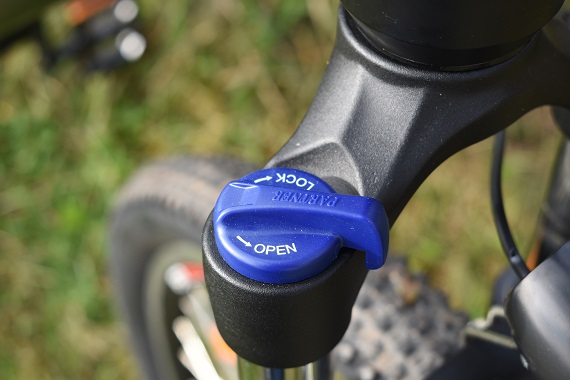Eskute Voyager Pro Review 2024

Eskute Voyager Pro Review: Overview
We’ve been looking forward to this Eskute Voyager Pro review for some time. Why? It gives us our first UK-based trial of a Bafang mid-drive in the form of the M200. Bafang class it as a “city” mid-drive rated at 65Nm torque — around the same as the highly regarded Bosch Performance Line Gen 3 motor — so, despite the “city” tag, the figures suggest it should be fine for at the very least moderate off-road use. The motor also weighs around the same as it’s nearest on-paper Bosch equivalent, the Performance Line, at 3.2kg. Would it rival Bosch’s impressive performance but at a much lower price?
We have already reviewed Eskute’s hub motor models, the Wayfarer and the Voyager and were impressed with the value for money that they both offered. The Pro versions now on offer both use Bafang M200 mid-drives and again, on paper, both look to offer great value on the UK market at £1549 (Eskute doesn’t sell in the US) – that price tag is at the very least several hundred pounds cheaper than most other mid-drive bikes out there.
Other upgrades on the new Pro versions include larger capacity batteries, hydraulic disk brakes and additional derailleur gears. The Voyager Pro tested here is the mid-drive version of Eskute’s leisure eMTB and with a powerful sounding mid-drive and 27.5” x 2.1” enduro style knobbies I was very curious to see how it would rival much more expensive Bosch-powered hardtail eMTBs.
 Pro’s
Pro’s- Great mid-drive performance for a reasonable price.
- The battery provides excellent range
- Most lights are something we recommend you upgrade. However, these hardwired front lights were pretty powerful.
- The tires roll well and have a tread pattern that allows for handling different types of terrrain
- Not a standard on all eMTBs, this bike has a sturdy kickstand
 Con’s
Con’s- Only the frontlight is hardwired (the front), we wish the rear one would have been as well.
- Having an level lower bottom gear would be a welcome addition.
- Battery: Long Ting 36V, 15Ah (540Wh)
- Display: Bafang LCD DPC07
- Motor: Bafang M200 mid-drive
- Headlight: D-033 hard wired to main battery with remote switch on handlebars
- Taillights: RL1800 budget model, battery powered (i.e. not hard wired to the main bike battery)
- Pedal Assist: Torque sensor integrated into mid-drive
- Range: 61 miles
- Throttle: No
- Battery Weight: 7lbs / 3.2kg
- Claimed bike weight: 51.6lbs / 23.4kg
- Real bike weight: 52.9lbs / 24.01kg
- Maximum rider weight: 120kg
- Maximum load on rear rack: N/A
- Dimensions: 71” /181cm long x 43” / 110cm high
- Brakes: Kamros hydraulic disks with 160mm rotors
- Fenders: Own brand, front and rear
- Fork: Strong branded, steel sprung
- Frame: Aluminium alloy
- Gearing: 9 speed derailleur, L-Twoo A5
- Grips: Rubberised, lock-on, own brand
- Saddle: Velo comfort
- Handlebar: Own brand alloy riser bars
- Kickstand: Own brand
- Pedals: Wellgo M195DU
- Tires: CST Jack Rabbit knobbies, 27.5″ x 2.1”
Eskute Voyager Pro Performance Review
Acceleration/Speed
The Bafang M200 mid-drive system feels like a high quality product. It starts to accelerate smoothly as soon as you apply pedal pressure (this is a ‘pure’ pedelec so there is no throttle control). Even in the lower power levels (one or two out of five levels) you can pick up speed very easily. In the higher levels you get pretty strong but steady acceleration which is a nice feature for negotiating city traffic where you might want to pull away quickly at a junction to get clear of standing traffic or on a hill start at a junction.
This is an EU spec e-bike and only for sale in Europe and the UK and that means the cut out limit for pedal assist is 15mph. There is no notable sudden ‘cut out’ of power at around 15mph, as the power progressively reduces, meaning you can cruise along at this speed without the sensation of power cutting in and out that you can get on some e-bikes with less sophisticated control systems.
Range Test
The Voyager Pro posted a range of 61 miles over hilly Pennine country with a total amount of climbing of 5177ft. This is an impressive performance by any measure amounting to around 10Wh of battery capacity per mile indicating a very efficient system as you might expect from a good quality mid-drive system.
The battery capacity meter is measured in 5 x 20% level bars that disappear as capacity starts to decline steadily. Towards the end of the battery capacity there was noticeably less climbing power but still some assist even down to just before when power cuts out and the battery capacity indicator is empty. This suggests perhaps the cut out parameters are set pretty widely by Eskute, so perhaps best to stop riding a little before the battery empties itself to protect its condition.
Circuit Test
Not surprisingly the Voyager Pro showed a huge improvement in lap time once the motor was turned on and also a marked increase in speed from level 1 to 2. Thereafter there was a relatively small but notable increase in speed through levels 3,4 and 5.
Whilst I’m a fan of having as few a levels as possible (I feel three is the optimum for practical use, ideally with rider-customisable power profiles) the five levels of the Voyager Pro showed nice gradation between levels and it was always possible to cruise along the flat at around 18 mph, even with the motor off. I was noticeably more out of breath on the climb in the lower levels and climbing was pretty easy in the top three levels, a fact you can’t tell by just looking at the times of course!

The Eskute Voyager Pro doesn’t need motor assist on the flat

Easy to use handlebar controls and a highly visible central screen

Large easy to control buttons by your left thumb
Hill Test
All UK tested e-bikes are tested over several runs on a 0.8 mile long constant road climb with plenty of 5% grade sections and the Voyager Pro’s time of 3-minutes and 5-seconds was a few seconds off the pace of more powerful mid-drives. There was a headwind which isn’t of course always there and despite this slower than average climb it felt really easy and pleasant to ride up and I was a little surprised the clock didn’t show a faster time. The motor power never showed any dead spots in this particular test and the power came and went very smoothly, in proportion to my pedal effort. It only dropped off one or two mph from its max assisted speed on the very steepest sections which also happened to be where the course is exposed to the strongest headwind.
TWe also do a much shorter but much steeper climb up a tarmac path with gradients of 15% plus and again, although the Voyager Pro was a few seconds off the pace of the likes of top of the line mid-drives from Bosch it felt an easy climb despite the steepness, with power in level 5 being applied evenly all the way – I was never having to force the pace to keep the motor spinning at its most efficient as can happen with cheaper hub motors. My only quibble was when changing gear with the chain under load on the steeper sections as there was a small break in the power delivery to the motor. Whether this is a deliberate feature to protect the chain from excess motor power I’m not sure.
In short this is all just the kind of performance you would expect from a quality mid-drive that is meant for good all round performance rather than out and out sporty riding – and that is just what the Bafang M200 is.
Handling
It also felt very maneuverable off-road, especially in tight turns and the responsive torque sensing power, nicely graduated power levels and progressive and powerful hydraulic disk brakes also made it easy to ride the bike in slightly technical off-road conditions, where close control was paramount

The Voyager Pro has a pretty comfortable yet sporty ride position and will handle a good variety of hilly terrain with ease

Reasonable performance from the budget steel spring forks

The seat is comfortable for a stock options
Eskute Voyager Pro Specs/Features Review: Electric Components
Motor
With on paper stats of 3.2kg / 7lbs weight and a torque rating of 65Nm it looks to be a direct competitor for Bosch’s Performance Line motor. We didn’t feel it gave quite the same punch out of the blocks but it still provided more than enough low speed torque in bottom gear for just about any hill – on or off road – and its performance in hill climbing terms lay somewhere between a Bosch Active Line Plus mid-drive (50Nm torque rating) and the Bosch Performance Line which has identical torque and weight specs to the Bafang M200.
Our only small gripe was the fact it very occasionally ‘stalled’ on very steep off-road hill climbs with the power momentarily cutting out – we suspect the consequence of us applying pedal pressure in too high a gear or perhaps changing gear under load. Whatever the reason, it didn’t stop our enjoyment of a wonderfully performing motor that’s especially impressive given the bike is priced at a level comparable with many hub motor e-bikes on the market.
Battery
The Voyager Pro comes with a 540Wh frame-integrated battery that locks into the top of the downtube securely with absolutely no rattle or movement whilst riding that we could detect – even over rougher terrain. It has a very solid alloy case with strong looking plastic at either end. In short, it looks very well made, at least from the outside.
The capacity is impressive and at least as much as you would expect on the average e-mtb or hybrid style e-bike. The brand is Long Ting and whilst it would be nice to have a more recognised name, at this kind of price there have to be some compromises in spec on a mid-drive at a sub £1600 price point, and this is clearly one of them.
Display
The central display is large and easy to read and gives you a relatively small number of data fields that are easy and quick to scroll though; trip length, odometer, max speed, average speed and estimated range. These sit beneath the permanently displayed speedometer and battery capacity meter info. The latter is a battery icon made up of a large number of capacity ‘bars’ and proved pretty accurate in measuring the gradual decline in battery capacity of during a long ride; certainly much more useful than the versions found on many cheaper hub motor models of e-bike that bounce up and down according to the load the battery is putting on the motor at any given time.
The large buttons on the separate hand control unit are easily accessible to your left thumb and like the display are highly ergonomic and make for an easy to use control setup, whether you are scrolling up or down the five power levels or turning the hardwired front LED on or off. It’s all in keeping with the function of the bikes as a leisure e-mtb that, whilst not obsessed with minimalism, has an emphasis on the useful and practical without going for information overload.

The Bafang M200 gives impressive climbing performance

Strong downtube construction with removable battery

Clear central display

The battery tucks away nicely in the frame for a sleek look
Eskute Voyager Pro Review: Components and Accessories
The brakes and gearing system used on the Voyager Pro are by L-Twoo and Kamros respectively; buyers might be so used to seeing Shimano and SRAM, even on budget e-bikes that they might be a little suspicious of new names rather than tried and trusted ones.
We found any such concerns would be misplaced as overall the componentry worked well, with one or two minor gripes covered in the detail below. Moreover, the components spec was suited to the mid-drive trail nature of the e-bike, giving smooth, powerful braking and reliable gear changing. Ten or more gears would have been even nicer as would a lower bottom gear, but overall we were pretty satisfied with all the components and accessories.
Brakes
The rear Kamros branded hydraulic disk brake at first behaved a little strangely, needing a few pumps of the brake level before it achieved full power – obviously not ideal. However, we unscrewed the small port on the fluid reservoir by the lever and this cured the problem; we guess a little air may have worked its way into the system and this seemed to release it.
From thereon, the Kamros brakes worked very well. There was plenty of power to stop very quickly if needed and they also provided quite sophisticated, progressive braking, which proved useful on our test of technical off-road handling.
Overall they are part of what makes the Voyager Pro such good value for money; a mid-drive, large capacity battery and capable hydraulic disc brakes are a high performing combination no doubt and found on few if any other e-bikes at this price.
Frame
The construction looks very strong, with meaty welds and a super strong looking and very beefy downtube which houses the frame-integrated battery. All this strength no doubt adds to the sizable heft of the bike at around 53lbs / 24kg. Despite the very solid construction it has nice clean lines, largely due to the frame-routed cables which are fed through the downtube to the motor (which also houses the controller) with rear brake and gear cables exiting at the back of the motor and running unobtrusively along the underside of the chainstays.
Fork
There’s not too much say about the fork other than it performs as you expect a budget steel sprung fork to. It took the edge off bigger bumps certainly though it did lack compression over smaller bumps and there was noticeable pogo-stick-like rebound if riding over a kerb for example with little useful damping.
Again, with all the great value going into the motor, battery size and brakes we would say this is an acceptable compromise and certainly some kind of front suspension is always useful on e-bike you are likely to want to take off-road regularly.
Drivetrain / Shifting
The L-Twoo A5 9-speed derailleur groupset performed well and shifted reliably – if sometimes somewhat noisily – under load. Whilst the gearing was fairly low, it would have been nice to have even lower gearing for the steepest off road climbs, the system offering a bottom gear ratio of around 96 gear inches from the combination of a 38 tooth front chainring and 32 tooth rear sprocket (and a top gear of 33 gear inches from the 11 tooth smallest rear sprocket).
Still, it’s a step up in the range of gearing offered compared to Eskute’s more budget hub motor models and that’s what you would expect on a mid-drive over a hub motor machine, as mid-drives can tackle steeper hills.
The derailleur itself looked reasonably well made but we can’t comment on its longevity – though at around $60 for a replacement available at AliExpress et al, if it does get damaged or wear out, a like- for-like replacement won’t break the bank.

The gearing offers plenty of climbing ability

Effective hydraulic disk brakes

Useful lockout suspension
Contact Points / Comfortability
The seat was well padded and plenty comfortable and together with the upright riding position gave a very comfortable-feeling ride.
Tires
The Voyager Pro runs on 27.5” x 2.1” (54-584) CST Jack Rabbit tires which combine great road speed and plenty of nice traction even in slippy, muddy off-road conditions. The latter is perhaps surprising given the gravel type nature of the tread (rather than using the aggressive knobbly tread you find on out and out performance e-mtbs). There is a layer of puncture protection consisting of tight weave poly-fiber material between the tread and the casing.
Extras / Accessories
There is a hardwired front LED light which gave great illumination, even on unlit roads and a battery powered rear light (red LEDs take far less power than white LEDs so this economizing makes sense, even if a hard wired rear light would have been nice). The Voyager Pro also comes with a sturdy kickstand and mtb type mudguards (i.e. offering some protection vs mud but not as good as full length ones). It’s possible to fit a rear pannier rack too, as there are two threaded attachment points near the bottom of the seat stays – though none near the top, so a suitable design should be used if you do wish to fit one.

A closer look at the Jack Rabbit tire tread

Tactile rubber lockon grips

The Voyager Pro is a great trail bike for all conditions
Eskute Voyager Pro Review: Summary / Where to Buy
The Eskute Voyager Pro would be a great choice if you want the performance benefits of a mid-drive – in the form of excellent hill climbing ability and impressive power consumption – without having to pay in the region of £2000 to £3000 which is the more usual price for a mid-drive on the UK market.
We were surprised how capable a hill climber it was, even off-road and how able it was on technical trails – whilst not in the same league as, say, a Bosch Performance-powered e-mtb it was certainly superior to every hub motor e-mtb or trail style e-bike without an independent throttle that we have tried (regular readers will know throttle only machines are not classed as e-bikes in the UK).
Who would the Voyager Pro suit? Perhaps ‘adventurous off-road beginner’ would be an ideal rider profile description. If you fancy the idea of trying off-road riding with some slightly technical and harder tracks mixed in with forestry tracks and the like but don’t feel ready to splash out thousands on a premium off-road machine then this e-bike sits pretty much in a niche of its own.
We are not talking a bike capable of extreme adrenaline inducing descents and vertiginous climbs with big rock steps, which much pricier e-mtbs may be made for, rather an e-bike that will allow you to dip a toe into trail conditions that are less perfect than smoothish fire roads and canal towpaths, which is the natural territory of many hub-motored e-mtbs; the responsive mid-drive and reassuring hydraulic disk brakes give you the performance potential to make that small step up that might lead on to bigger and more expensive things one day…
Having said all this the Voyager Pro would also make a great commuter or leisure e-bike if fitted with a rack, especially if you have lengthy unsurfaced tracks you want to cover on a regular basis – the combination of large battery and efficient motor give that impressive range whilst the comfortable ride quality also lends itself to longer days in the saddle.
Whilst there appears to be the occasional third party retailer of Eskute e-bikes, the brand is, by and large, a direct to consumer set up, with a Chinese HQ, an assembly plant in Poland and a UK warehouse, but no dealer network in the UK. In other words you buy direct from the manufacturer and get any spares or replacement parts directly from them too.
‘Happy Riding, make sure to let us know if you have any questions down in our comments section or if you think we left anything out in this review of the Eskute Voyager Pro.


